Actualité volcanique, Articles de fond sur étude de volcan, tectonique, récits et photos de voyage
The largest part of the island of Hawaii is submarine ... it is the same for the
Kilauea volcano.
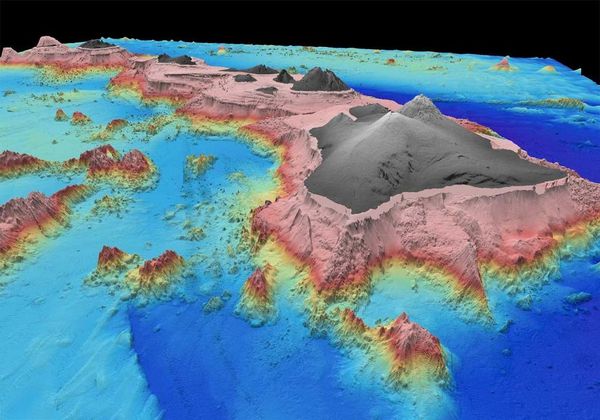 Hawaiian
archipelago, with Big Island in the foreground - the emergent parts are gray - immersed parts in different colors depending on their depth - Doc. Avcan
Hawaiian
archipelago, with Big Island in the foreground - the emergent parts are gray - immersed parts in different colors depending on their depth - Doc. Avcan
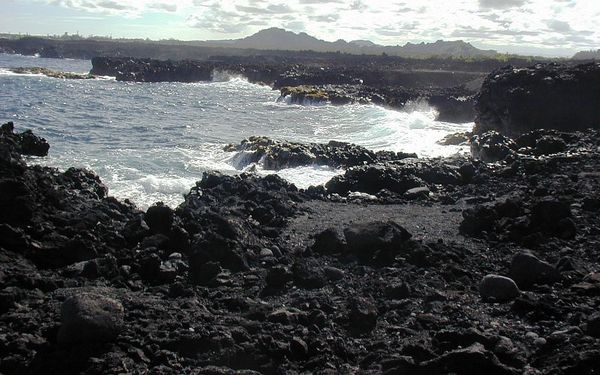 Big Island / Hawaii - Cape Kumukahi , tip tip of the East Rift Zone - photo HVO - USGS .
Big Island / Hawaii - Cape Kumukahi , tip tip of the East Rift Zone - photo HVO - USGS .
The
east rift zone of Kilauea not stop therefore
at the coast, but continues 75 km under the sea beyond Cape Kumukahi , towards the NE, to reach a depth of 5,400 meters. The immersed part is known as the Puna ridge.
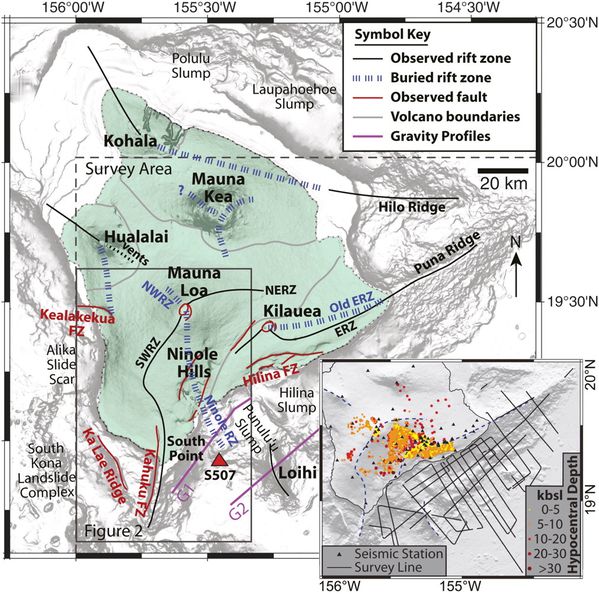 Big Island / Hawaii - morphology - Doc. USGS
Big Island / Hawaii - morphology - Doc. USGS
Location of Rift zones ( ERZ : East Rift Zone) , ridges and
volcanoes.
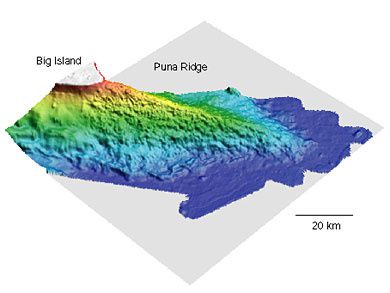 3D view of the dorsal Puna - Doc. USGS
3D view of the dorsal Puna - Doc. USGS
 Big island - bathymetry of the Puna and Hilo ridges
Big island - bathymetry of the Puna and Hilo ridges
Doc. J.Robinson - JMSTC , USGS , Monterey inst, Scripps Inst Oceanogr
Its average slope is 50 meters per
kilometer to a depth of 2800 m. , then goes deeper than 100 meters / km . (By comparison, the average
slope of the visible part is 23 m / km.)
Dorsal Puna
is surrounded on the north and south by underwater expanded lava flows ; these, discovered in 1986, are coming from the deepest of the dorsal segment. Its east end partially covers an area of a
more ancient rift , known as the Hilo ridge, in connection with the Kohala volcano.
Its historical activity back to the late 18th
century, according to Hawaiian oral tradition , but without clear evidence . In 1884,
an eruption day was observed at a depth of only 20 meters.
In
the early 60s , the first pictures and samples onto the bottom of the Puna ridge show that the axis of the rift zone consists of young pillow flows, of similar chemical composition of lava
to those emitted by the Kilauea in subsurface.
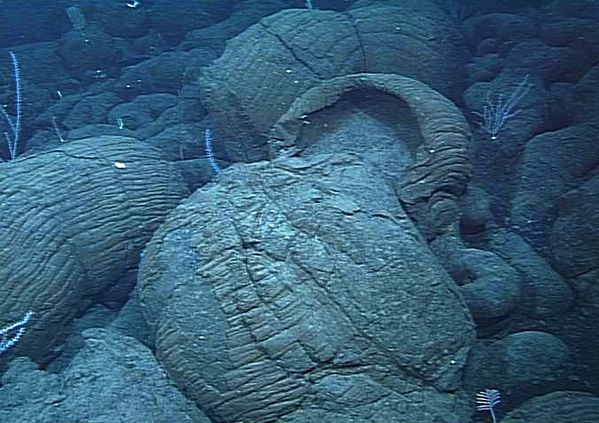 Puna ridge : Pillow lavas at a depth of 2107 m - photo 2001 MBARI (Monterey Bay Aquarium Research Institute)
Puna ridge : Pillow lavas at a depth of 2107 m - photo 2001 MBARI (Monterey Bay Aquarium Research Institute)
The following research has identified a wide variety of volcanic features , similar or different from those encountered in the open air structures : cracks, pit-craters, skylights ( lava tube ) ,
cones, pillow ridge, terraces of lava.
Terraces form vaguely circular structures, relatively flat or slightly curved in surface ( visible on the bathymetry , near Cape Kumukahi )
they are prominent, several kilometers wide and high of several hundred meters, and an estimated volume up one km³ . Some terraces have one or more summit craters .
They are supposed to result from long-term eruptions , which have extruded lava with
low or moderate rates.
Various hypotheses have been proposed to explain the growth: inflation upwards and outside of the submarine network of lava tubes, or lava accumulation behind dams, like lava lake ... a decisive
factor is the low temperatures underwater.
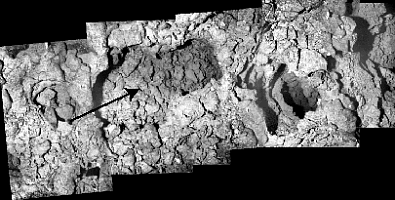 Puna ridge - Skylight indicated by the arrow - doc . D. Smith , Woods Hole Oceanographic
Puna ridge - Skylight indicated by the arrow - doc . D. Smith , Woods Hole Oceanographic
Skylights mark the path of lava . The most important are located on a terrace at a depth of 1,100 meters
on the edge of a crater 150-200 m. in diameter. The deeper is around 3500
meters.
Circular cones , up to 2500 m . in diameter and a height of 140 m. punctuate the Puna ridge. They have a flat top and a crater , as the
subaerial cones ; a deep crater suggests a drainage of lava , after the formation of the cone .
Small cones , known as hornitos surface with a diameter less than 100 m . and almost vertical
walls, are covered with rubble and tubular pillow , and assumed to have formed on the surface of a flow, or over a lava tube .
High, narrow ridges - a few meters to 200 m. wide and a height of up to 30 m .
- Up to several kilometers in length and composed mainly of pillow lava are called pillow ridge
or pillow walls, if their sides are very steep.
These pillow ridges are interpreted as primary
vents built directly on an underwater crack . This
crack is not more visible, buried under an accumulation of pillow lava or lava tube .
Eruptions
on the Puna Ridge, and there feeding by dykes, appear more viable thermally than there supplied in the same way in subaerial . Therefore , eruptions on the
submerged ridge are more durable, and involve larger volumes than those occurring on the emerged east rift zone. ( Parfitt )
Sources :
- HVO - Puna ridge : underwater segment of the Kilauea East Rift Zone - 2002 - link
- Volcanic structure of the crest of the Puna Ridge, Hawaii: Geophysical implications of submarine volcanic terrain - By DAniel J.Fornari & al.
- Internal structure of Puna ridge : evolution of the submarine east Rift zone of Kilauea volcano , Hawaii - by Stephen Leslie & al. - link
- A compraraison between subaerial and submarine eruptions at Kilauea volcano, Hawaii : implications for the thermal viability of lateral feeder dikes. - by Elisabeth Parfitt & al.
Thème Magazine - Hébergé par Overblog

